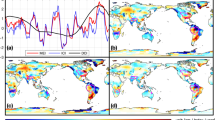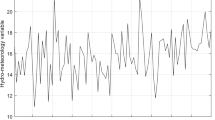Abstract
The Western Antarctic Peninsula is one of the most rapidly warming regions on earth. It is therefore important to analyze long-term trends and inter-annual patterns of change in major environmental parameters to understand the process underlying climate change in Western Antarctica. Since many polar long-term data series are fragmented and cannot be analysed with common time series analysis tools, we present statistical approaches that can deal with missing values. We applied U-statistics after Pettit and Buishand to detect abrupt changes, dynamic factor analysis to detect functional relationships, and additive modelling to detect patterns in time related to climatic cycles such as the Southern Annular Mode and El Niño Southern Oscillation in a long-term environmental data set from King George Island (WAP), covering 20 years. Our results not only reveal sudden changes for sea surface temperature and salinity, but also clear patterns in all investigated variables (sea surface temperature, salinity, suspended particulate matter and Chlorophyll a) that can directly be related to climatic cycles. Our results complement previous findings on climate related changes in the King George Island Region and provide insight into the environmental conditions and climatic drivers of system change in the study area. Hence, our statistical analyses may prove valuable for other polar environmental data sets and contribute to a better understanding of the regional variability of climate change and its impact on coastal systems.





Similar content being viewed by others
References
Akaike H (1974) A new look at the statistical identification model. IEEE Trans Autom Control 19:716–723
Blindow N, Suckro SK, Rückamp M, Braun M, Schindler M, Breuer B, Saurer H, Simoes JC, Lange MA (2010) Geometry and thermal regime of the King George Island ice cap, Antarctica, from GPR and GPS. Ann Glaciol 51(55):103–109
Brey T, Voigt M, Jenkins K, Ahn I-Y (2011) The bivalve Laternula elliptica at King George Island—a biological recorder of climate forcing in the West Antarctic Peninsula region. J Mar Syst 88(4):542–552. doi:10.1016/j.jmarsys.2011.07.004
Buishand TA (1984) Tests for detectung a shift in the mean of hydrological time-series. J Hydrol 73(1–2):51–69
Caloiero T, Coscarelli R, Ferrari E, Mancini M (2011) Trend detection of annual and seasonal rainfall in Calabria (Southern Italy). Int J Climatol 31(1):44–56. doi:10.1002/joc.2055
Clarke A, Griffiths HJ, Barnes DKA, Meredith MP, Grant SM (2009) Spatial variation in seabed temperatures in the Southern Ocean: implications for benthic ecology and biogeography. J Geophys Res Biogeosci 114. doi:10.1029/2008jg000886
Cleveland RB, Cleveland WS, McRae JE, Terpenning I (1990) A seasonal-trend decomposition procedure based on loess. J Off Stat 6:3–73
Ducklow HW, Baker K, Martinson DG, Quetin LB, Ross RM, Smith RC, Stammerjohn SE, Vernet M, Fraser W (2007) Marine pelagic ecosystems: the West Antarctic Peninsula. Philos Trans R Soc B Biol Sci 362(1477):67–94
Eraso A, Dominguez MdC (2007) Physicochemical characteristics of the subglacier discharge in Potter Cove, King George Island, Antarctica. vol 45. University of Silesia, Wroclaw
Fogt RL, Bromwich DH, Hines KM (2011) Understanding the SAM influence on the South Pacific ENSO teleconnection. Clim Dyn 36(7–8):1555–1576. doi:10.1007/s00382-010-0905-0
Gillet NP, Kell TD, Jones PD (2006) Regional climate impacts of the southern annular mode. Geophys Res Lett 33:L23704. doi:10.1029/2006GL027721
Gong DY, Wang SW (1999) Definition of antarctic oscillation index. Geophys Res Lett 26(4):459–462. doi:10.1029/1999gl900003
Hastie T, Tibshirani R (1986) Generalized additive models (with discussion). Stat Sci 1:297–318
Jalles JT (2009) Structural time series models and the Kalman Filter: a concise review. FEUNL Work Pap 541. doi:10.2139/ssrn.1496864
Kiely G, Albertson JD, Parlange MB (1998) Recent trends in diurnal variation of precipitation at Valentia on the west coast of Ireland. J Hydrol 207(3–4):270–279
Kundzewicz Z, Robson AJ (2004) Change detection in hydrological records—a review of the methodology. Bull Hydrol 49(1):7–19
Loeb V, Hofmann EE, Klinck JM, Holm-Hansen O (2010) Hydrographic control of the marine ecosystem in the South Shetland-Elephant Island and Bransfield Strait region. Deep-Sea Res II Top Stud Oceanogr 57(7–8):519–542. doi:10.1016/j.dsr2.2009.10.004
Marshall GJ (2002) Analysis of recent circulation and thermal advection change in the northern Antarctic Peninsula. Int J Climatol 22(12):1557–1567. doi:10.1002/joc.814
Marshall GJ (2007) Half-century seasonal relationships between the Southern Annular Mode and Antarctic temperatures. Int J Climatol 27(3):373–383. doi:10.1002/joc.1407
Martinson DG, Stammerjohn SE, Iannuzzi RA, Smith RC, Vernet M (2008) Western Antarctic Peninsula physical oceanography and spatio-temporal variability. Deep-Sea Res II Top Stud Oceanogr 55(18–19):1964–1987. doi:10.1016/j.dsr2.2008.04.038
Meredith MP, King JC (2005) Rapid climate change in the ocean west of the Antarctic Peninsula during the second half of the 20th century. Geophys Res Lett 32(19). doi:10.1029/2005gl024042
Meredith MP, Murphy EJ, Hawker EJ, King JC, Wallace MI (2008) On the interannual variability of ocean temperatures around South Georgia, Southern Ocean: forcing by El Nino/Southern Oscillation and the Southern Annular Mode. Deep-Sea Res II Top Stud Oceanogr 55(18–19):2007–2022. doi:10.1016/j.dsr2.2008.05.020
Monaghan AJ, Bromwich DH, Chapman W, Comiso JC (2008) Recent variability and trends of Antarctic near-surface temperature. J Geophys Res Atmos 113(D4). doi:10.1029/2007jd009094
Montes-Hugo M, Doney SC, Ducklow HW, Fraser W, Martinson D, Stammerjohn SE, Schofield O (2009) Recent Changes in Phytoplankton Communities Associated with Rapid Regional Climate Change Along the Western Antarctic Peninsula. Science 323 (5920):1470–1473. doi:10.1126/science.1164533
Monien P, Schnetger B, Brumsack HJ, Hass HC, Kuhn G (2011) A geochemical record of late Holocene palaeoenvironmental changes at King George Island (maritime Antarctica). Antarct Sci 23(3):255–267. doi:10.1017/s095410201100006x
Murphy EJ, Watkins JL, Trathan PN, Reid K, Meredith MP, Thorpe SE, Johnston NM, Clarke A, Tarling GA, Collins MA, Forcada J, Shreeve RS, Atkinson A, Korb R, Whitehouse MJ, Ward P, Rodhouse PG, Enderlein P, Hirst AG, Martin AR, Hill SL, Staniland IJ, Pond DW, Briggs DR, Cunningham NJ, Fleming AH (2007) Spatial and temporal operation of the Scotia Sea ecosystem: a review of large-scale links in a krill centred food web. Philos Trans R Soc B Biol Sci 362(1477):113–148. doi:10.1098/rstb.2006.1957
Orr A, Marshall GJ, Hunt JCR, Sommeria J, Wang CG, van Lipzig NPM, Cresswell D, King JC (2008) Characteristics of summer airflow over the Antarctic Peninsula in response to recent strengthening of westerly circumpolar winds. J Atmos Sci 65(4):1396–1413. doi:10.1175/2007jas2498.1
Pakhomov EA, Fuentes V, Schloss I, Atencio A, Esnal GB (2003) Beaching of the tunicate Salpa thompsoni at high levels of suspended particulate matter in the Southern Ocean. Polar Biol 26(7):427–431. doi:10.1007/s00300-003-0494-z
Pettitt AN (1980) Some results on estimating a change-point using nonparametric type statistics. J Stat Comput Simul 11(3–4):261–272
Pettitt AN (1981) Posterior probabilities for a change-point using ranks. Biometrika 68(2):443–450
Philipp EER (2010) Suspended paticulate matter measured at three station in Potter Cove, King George Island, Western Antarctic Peninsula. doi:10.1594/PANGAEA.746016
Rückamp M, Braun M, Suckro S, Blindow N (2011) Observed glacial changes on the King George Island ice cap, Antarctica, in the last decade. Global and Planetary Change in press (available online 6 July 2011). doi:10.1016/j.gloplacha.2011.06.009
Russell A, McGregor GR (2010) Southern hemisphere atmospheric circulation: impacts on Antarctic climate and reconstructions from Antarctic ice core data. Clim Chang 99(1–2):155–192. doi:10.1007/s10584-009-9673-4
Schloss IR, Ferreyra GA, Mercuri G, Kowalke J (1999) Particle flux in an Antarctic shallow coastal environment: a sediment trap study. Sci Mar 63:99–111
Schloss IR, Abele D, Moreau S, Demers S, Bers AV, Gonzáles O, Ferreyra GA (2012) Response of phytoplankton dynamics to 19-year (1991–2009) climate trends in Potter Cove (Antarctica). J Mar Syst 92:53–66. doi:10.1016/j.jmarsys.2011.10.006
Schofield O, Ducklow HW, Martinson DG, Meredith MP, Moline MA, Fraser WR (2010) How do polar marine ecosystems respond to rapid climate change? Science 328(5985):1520–1523. doi:10.1126/science.1185779
Smith CA, Sardeshmukh P (2000) The effect of ENSO on the intraseasonal variance of surface temperature in winter. Int J Climatol 20:1543–1557
Smith RC, Martinson DG, Stammerjohn SE, Iannuzzi RA, Ireson K (2008) Bellingshausen and western Antarctic Peninsula region: pigment biomass and sea-ice spatial/temporal distributions and interannual variabilty. Deep-Sea Res II Top Stud Oceanogr 55(18–19):1949–1963. doi:10.1016/j.dsr2.2008.04.027
Stammerjohn SE, Martinson DG, Smith RC, Yuan X, Rind D (2008) Trends in Antarctic annual sea ice retreat and advance and their relation to El Nino-Southern Oscillation and Southern Annular Mode variability. J Geophys Res Oceans 113(C3). doi:10.1029/2007jc004269
Stammerjohn S, Massom R, Rind D, Martinson D (2012) Regions of rapid sea ice change: an inter-hemispheric seasonal comparison. Geophys Res Lett 39. doi:10.1029/2012gl050874
Tatian M, Sahade R, Mercuri G, Fuentes VL, Antacli JC, Stellfeldt A, Esnal GB (2008) Feeding ecology of benthic filter-feeders at Potter Cove, an Antarctic coastal ecosystem. Polar Biol 31(4):509–517. doi:10.1007/s00300-007-0379-7
Turner J, Harangozo SA, Marshall GJ, King JC, Colwell SR (2002) Anomalous atmospheric circulation over the Weddell Sea, Antarctica during the Austral summer of 2001/02 resulting in extreme sea ice conditions. Geophys Res Lett 29(24). doi:10.1029/2002gl015565
Turner J, Colwell SR, Marshall GJ, Lachlan-Cope TA, Carleton AM, Jones PD, Lagun V, Reid PA, Iagovkina S (2005) Antarctic climate change during the last 50 years. Int J Climatol 25(3):279–294
Vaughan DG (2006) Recent trends in melting conditions on the Antarctic Peninsula and their implications for ice-sheet mass balance and sea level. Arct Antarct Alp Res 38(1):147–152
Vaughan DG, Marshall GJ, Connolley WM, Parkinson C, Mulvaney R, Hodgson DA, King JC, Pudsey CJ, Turner J (2003) Recent rapid regional climate warming on the Antarctic Peninsula. Clim Chang 60(3):243–274
Wood SN (2006) Generalized additive models–an introduction with R. Chapmann & Hall/CRC, Boca Raton
Yuan XJ (2004) ENSO-related impacts on Antarctic sea ice: a synthesis of phenomenon and mechanisms. Antarct Sci 16(4):415–425. doi:10.1017/s0954102004002238
Zuur AF, Pierce GJ (2004) Common trends in northeast Atlantic squid time series. J Sea Res 52(1):57–72. doi:10.1016/j.sears.2003.08.008
Zuur AF, Fryer RJ, Jolliffe IT, Dekker R, Beukema JJ (2003) Estimating common trends in multivariate time series using dynamic factor analysis. Environmetrics 14(7):665–685. doi:10.1002/env.611
Zuur AF, Ieno EN, Smith GM (2007) Analysing ecological data. Statistics for biology and health. Springer, New York
Zuur AF, Ieno EN, Walker NJ, Saveliev AA, Smith GM (2009) Mixed effects models and extensions in ecology with R. Statistics for biology and health. Springer, New York
Acknowledgments
This study is part of the IMCOAST program, which is part of the PolarClimate program of the European Research Council within the ERA-Net Europolar. This particular subproject was funded by the German Federal Ministry of Education and Research (BMBF, ref. no. 03F0617A). We thank the Servicio Meteorológico Nacional of the Argentine Air Force for providing the air temperature data and IAA, DNA and AWI for supporting 20 years of cooperative field work at Carlini Station-Dallmann laboratory.
Author information
Authors and Affiliations
Corresponding author
Rights and permissions
About this article
Cite this article
Bers, A.V., Momo, F., Schloss, I.R. et al. Analysis of trends and sudden changes in long-term environmental data from King George Island (Antarctica): relationships between global climatic oscillations and local system response. Climatic Change 116, 789–803 (2013). https://doi.org/10.1007/s10584-012-0523-4
Received:
Accepted:
Published:
Issue Date:
DOI: https://doi.org/10.1007/s10584-012-0523-4




